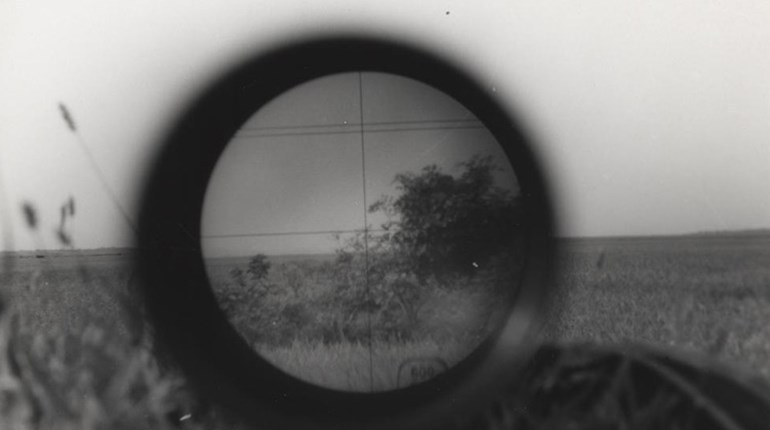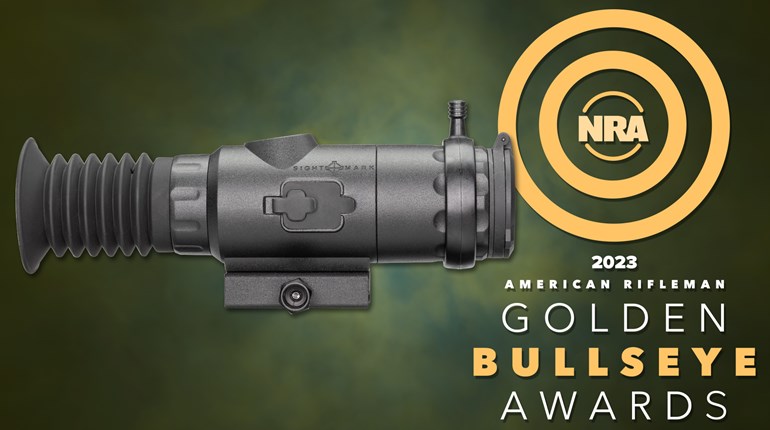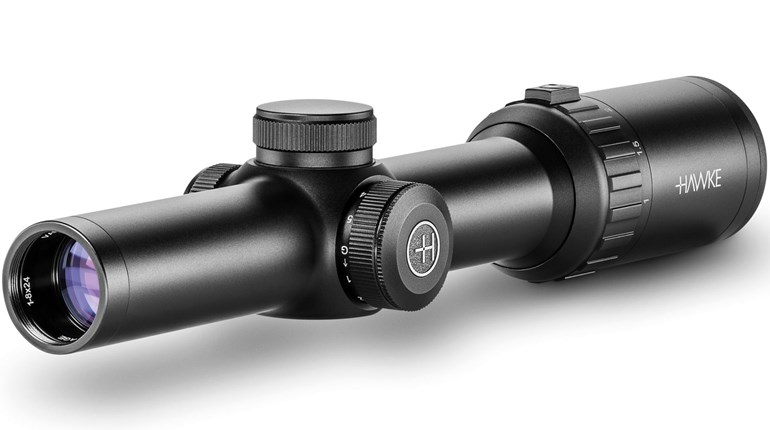
Styles, prices and levels of quality for various NVDs are all over the place but the single tube AN/PVS-14 (and commercial variants) is one example of a good general-purpose monocular. Available at multiple price and quality levels, the PVS-14 is standard issue for many of our ground troops.
While the commercial and mil-spec Gen III and Gen III+ image-intensification tubes are very good, options for using the PVS-14 to engage targets have traditionally been limited to two categories: decent and crappy. The former requires wearing the monocular on a helmet or head harness/medieval torture mask and using an infrared laser-aiming device zeroed for the firearm. This method provides the best situational awareness, because the shooter is able to scan a wide area independent of the rifle since the monocular is worn. However, laser-designated shooting is less than precise due to the IR beam's relatively large, diffused spot downrange and the difficulties involved with matching laser and projectile trajectories at multiple distances.
The less-popular method of night-vision-monocular employment is to mount the device behind a day optic. This technique allows the use of available day-scope magnification and reticle features and is more accurate than laser engagement, but it is also cumbersome. Loss of eye relief from having the 4.5-inch-long PVS-14 tube placed between your face and the regular scope makes shooting this way a somewhat hellish experience. Snipers have long preferred inline night-vision optics like the AN/PVS-22 that mount in front of their day scopes for this very reason. Unfortunately, high-quality versions of these devices start in the neighborhood of $8,000 to $10,000.
Optical limitations prevent rear-mounted night-vision devices like the PVS-14 from being used in front of a day scope by themselves. Last year, Black Optex introduced a clever solution to this problem in its Zero Lens Optical Alignment Adapter. This clip-on unit literally bridges the gap between day and night optics, creating a functional, front-mounted night-vision scope that gives shooters a third attachment option for the PVS-14 family.
Retired Army SOF operator and Black Optex's resident subject matter expert Ben Bethke claims using the Zero Lens is akin to having a quick detachable (QD) mount and windage/elevation adjustments temporarily attached to a PVS-14. The adjustments "steer" the image produced by the PVS-14, so it precisely aligns with and overlays the day optic image. A short bracket extends in front of the Zero Lens, forming a cradle into which the PVS-14 is seated. A threaded thumbscrew secures the night optic to this extension.
Once adjusted to a specific PVS-14, the Zero Lens system does not change a riflescope's zero. The whole assembly (Zero Lens and PVS-14) can be removed from the firearm and then replaced without zero shift as long as the capped adjustment knobs aren't disturbed. It can even be mounted onto another gun with a different type of day optic and remain zeroed for that rifle, too, assuming its day optic is already zeroed.
I tested two PVS-14s (one mil-spec Gen III+ and one commercial Gen III) with my test sample and confirmed this product works as advertised. Bethke told me the PVS-14 may be removed from the Zero Lens for hand-held or head-mounted use, and then reinstalled on the same Zero Lens without loss of zero, but I did not test this capability.
The Zero Lens was conceived for use with military-issue optics like those in the Trijicon ACOG, Aimpoint and EoTech families. It also works with magnified optics, but as with all image-intensified attachments, the image quality is directly affected by the day scope's internal design. Additional lenses, small objectives and higher powers each result in lower-resolution images. An included 3X adapter lens is required to maintain the day optic's true magnification. Without the adapter threaded onto the PVS-14's objective lens, day scope magnification is reduced by 2/3. Accordingly, a 6X sight would appear to be 2X if the adapter is not used.
I began my test with a 1-4x30 mm optic and had no difficulty adjusting the Zero Lens to match my scope's 100-yard zero. Under 60-percent illumination, image resolution was good enough to see my 18-inch silhouette target, but the finer details were not clear. I could only make out shapes beyond 100 yards, so target identification was impossible beyond that distance. I dialed my scope's power down to 2X and could observe clearly out to 150 yards (the limit of my night range) and identify all targets, even with reduced image sizes. Likewise, when I removed the 3X adapter and dialed my day scope up to 4X, the 1/3-size target image was very clear. Repeating the process with a 1-6.5x30 mm scope produced identical results.
I also tried a 3.5X ACOG to see if clarity would improve using a fixed-power scope. The ACOG's tritium reticle was clear and easy to use, even though the target image was a bit fuzzy with the 3X adapter attached. After removing the adapter, the view was just like that of a reflex sight—a crisp reticle and a barely magnified, clear, target image. Resolution was far superior to the other scopes, and also better than when trying to look through the ACOG with a head-mounted NVD. I found no matter which optic I mounted the Zero Lens in front of, a fair bit of trial and error was needed to fine-tune the various PVS-14 and day optics' focal adjustments.
The combined cost of the Zero Lens kit and a Gen III PVS-14 is less than half the cost of a good PVS-22-type NVD. The image quality is not the same, but it may be well suited for shooters needing an inline optic on a budget—especially for use in front of a low-power sight. This setup would work well for static observation and security or varmint/predator control. The Zero Lens has the added advantage of being a passive system. Unlike IR aiming lasers, the Zero Lens does not project a "Here I am!" infrared beam to betray the shooter's position to someone wearing even the cheapest night-vision gear.
In 2012 Black Optex released a 6X lens, a QD mounting system for the 3X and 6X lenses and a PVS-18 mount. The 2013 SHOT Show saw the unveiling of a Fusion system that mates thermal and image-intensification capabilities into a single very handy unit. Several U.S. and allied military organizations are currently evaluating the Zero Lens system.
Specifications:
Field of View: 13 degrees (with 3X adapter lens)
Optical Height Above Mounting Surface: 1.6 inches
Adjustment Value: 1/2 MOA per elevation/windage click
Length: 5.7 inches, Zero Lens only;
9.74 inches with PVS-14
Weight: 16.1 ounces, Zero Lens only;
1 pound, 15 ounces with PVS-14
Operating Temperature: -60 to +120 degrees Fahrenheit
Accessories: 3X adapter, QD mount for mil-std 1913 rail, hard and soft cases, lens cleaning kit, manual
MSRP: $1,695


































